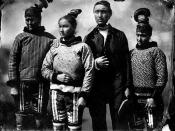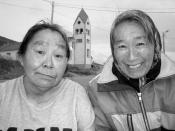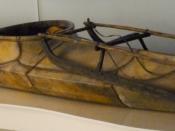INUIT(IN U IT)
100(100) WORDS(WORDS) FOR(FOR) SNOW(SNOW) NO(NO) WORD(WORD) FOR(FOR) TRIBE(TRIBE) AND(AND) A(A) NAME(NAME) THAT(THAT) MEANS(MEANS) ''PEOPLE'(PEOPLE)
SETTLEMENT
The Inuit way of life began some 10,000 years ago in the Bering Strait. The Inuit's early ancestors are believed to be the second major group of migratory settlers to cross the Bering land bridge. As part of the Aleut Eskimo language family the Inuit migrated across the bridge and by 8,500 B.C. are believed to have established several coastal villages around the Bering Strait area. During this time the Inuit population began to thrive, due in no small part to the abundance of food in that area, and in doing so needed more land to sustain the growing population. The Inuit undertook another mass migration splitting into several sub-groups, or bands, and heading in different directions. The exact date of this migration can only be speculated. The Inuit are believed to have migrated north along the coast and possibly inland towards large rivers and valleys.
Their way of life must have been very successful for the Inuit undertook yet another migration around the time of 5000 BC, spreading eastward from Alaska and into what is now known as the Northwest Territories. This group of people, called the "Sivullirmuit" (meaning first people) by the Inuit's and the 'Dorset' by archaeologists, spread eastward across Canada settling as far east as the Belle Isle in Newfoundland. Above you will find a map showing the possible migratory routes across Canada the Inuit may have taken. Note the vast area covered in their travels. This has led me to believe that the Inuit were less attached to their territory as some of the other Canadian native tribes are. It seems unlikely that such a nomadic race of people placed any great importance on territorial boundaries.
.
Life
The Sivullirmuit migration into the baron tundra immersed them into an environment the likes of which they had never seen. Rather than forest, rivers and ocean the Inuit now saw tundra, glaciers and, well, more tundra. The north bound Sivullirmuit were faced with new daily struggles for survival and had to learn and create new skills and technologies. As they migrated north they soon found sea and river fishing to be either an impractical or impossible way of food gathering. Rather than abandoning the migration the Inuit capitalized on the abundance of large sea and land mammals living on the ice shelf. These mammals provided a very secure lifestyle with their abundance and size (a small whale weighing 5 tonnes) allowing them to focus on developing the survival skills necessary for survival in the harsh climate.
The Sivullirmuit hunted with finely crafted tools and weapons made out of stone, ivory or bone. They were so finely crafted that even the most skilled modern Inuit craftsmen are awe inspired by the quality of the tools and carvings. These tools endure today as an important part of the modern Inuit heritage. They are of great spiritual and even magical importance to existing Inuit. The bow and arrow, the harpoon, fish spears and weirs were the weapons of choice. The Inuit used the dogsled and polar bear skins to transport heavy loads over great distances. The sea faring Inuit hunted whale seals and walrus from seal skin kayaks (vessels renowned for their manoeuvrability, a quality very necessary for dodging whale tails!).
The majority of the Sivullirmuit hunted sea mammals such as whales, walruses and seals for food, fuel, cooking oil, and raw materials for tools and weapons, the exception being the Sivullirmuit who migrated east from their home in the Bering strait to central Canada where caribou, birds and fish made easier game than sea mammals. The artic bound Inuit had obtainable to them only a very limited diet which for the most part consisted of nothing more than the sea mammals. Mal nutrition surely would have been their undoing had it not been for the practice of raw meat eating (frowned upon by other native races) that kept in tact the essential nutrients that would have been destroyed by heat. No part of the animal was wasted. Everything from the internal organs and in some cases even the fecal matter of the animal was consumed. There is speculation as to why they ate their meat raw but it is greatly believed that the conservation of the already scarce fuel played a large part in their decision.
Being a seasonally nomadic race of people the Sivullirmuit traditionally used various types of housing. In warmer times they sheltered in caribou or seal skin tents, in colder times partially sub-terrainian bunkers made of sod, drift wood and occasionally stone placed over the underground floors provided adequate insulation against the harsh cold. The trademark igloo of the artic people was only incorporated into life styles of some of the Inuit. These structures were typically used for overnight protection against the cold on long journeys. They dressed in clothing made of caribou hide and made parkas, breeches, mittens, boots and even snow goggles.
THE INUIT DIVISION
The Inuit are divided into two strongly related groups based on language, environment and culture. The Yupik inhabit the southwest coast of Alaska, Nunivak, and the St. Lawrence Islands. Their numbers are estimated to be in the range of 25,000 in Alaska and 1,300 in Russia. The Yupik language is closely related to the other (Inupait) language though despite this the two groups regard the others language as unintelligible. There are many other features that differentiate the two groups.
The second language group is known as the Inupait group. Spreading from north Alaska through Canada and on to Greenland these 125,000 Inuit differ greatly within themselves. With such a vast distance between them the separate groups have evolved variations both culturally and linguistically.
SOCIAL POLITICAL ORGANIZATION
The Inuit were separated into small nomadic groups or bands ranging in size from 60-300 people. This band usually occupied a series of camps consisting several, or even a single large house hold. Typically each household was occupied by one family. All major decisions were made by the eldest men and women of the camp. Men made the decisions on when to move camp (usually based upon the migratory patterns of the herd they were following) and women made household related decisions. Each band usually had one 'de facto' leader who was chosen for his experience and perceived wisdom. This leader was rarely given absolute authority however he did influence the social, ritual and economic decisions greatly. Next in rank came the shaman, or the religious authority. This job was filled by men for the most part but women were occasionally chosen for the title. The Shaman's job was to advise the band and the leader on the will and intentions of the gods, provide spiritual protection and also to predict the movements of the game. There were occasional power struggles between the band leader and the Shaman.
Being such a wide spread and nomadic people the Inuit were unable to developed any form of centralized government. The constant search for food together with the instilled nomadic life styled forced the many bands of Inuit far away from each other and prevented the society from progressing as a whole. (This sort of centralized government and social organization determines which civilizations come to power and which do not. The Incas are a perfect example, the enjoyed a strong government and social organization and conquered much of South America. They remained in power until they were conquered by the Europeans who had superior technology and military as a result of a greater government. This is all explained in the book 'Guns Germs and Steel' by Jared Diamond)
RELIGION AND CREATION
Life in the artic can be described in two words; harsh and monotonous. Before European contact the Inuit new of nothing more than snow, coldness, white, snow and more snow. It is therefore understandable that their 'religion' speaks very little of a life after death. The Inuit knew of no greater place. They knew nothing of warmth and plenty, only of coldness and desolation. The life of an ancient Inuit was without pleasures; as a result their religion speaks little of reward and utopia. The Inuit lived much in the same way as did the earliest hunter gatherers; focusing solely on survival. Their religion is weak and offers only fable explanations to the mysteries of everyday life. While Europe and the Middle East where busy creating structured religion and government the Inuit were still tirlessly searching for food. It is because of their un-materialistic and philosophically void life that I think they would have made perfect Buddhists.
Having said that I shall now go to offer some insight into the Eskimo spiritual world. Please note that this 'religion' may take on slight variations from band to band as a result of their seclusion.
The ocean is the single most productive resource in the artic and as such it was paid homage in the form a 'good' god with an entertaining tale. The ocean was inhabited by the god 'Sedna' who that jumped in the ocean one day after a terrible argument with her father. Her fingers and toes gradually became frost bitten by the harsh cold and turned into seals and whales and walrus'. She is seen as the creator of all life in the ocean and was frequently asked for compassion and generosity. The surface world had 'Sila' the creator of all living land animals. She was responsible for giving all animals a soul and life; consequentially she was far more important to the caribou Inuit than to the sea mammal hunting Inuit. The Inuit see both Gods creations as a means for their survival.
The Inuit did have a certain respect for all living things and had ritual dances or ceremonies before every hunt (This belief can be seen commonly throughout the native peoples of North America). The Inuit believed that all living beings had a soul. These souls could be categorized into three groups, name souls, personal souls, ghosts and, most importantly, human souls. The Inuit believed that beings strength came from its soul and that this soul was immortal (isn't it strange how so many societies have come to believe in an eternal soul?). To the Inuit names were not just ways of labeling everything, they were ways of creating spiritual protection and grading an individual's power. An Inuit could thus posses many names, some for spiritual protection and some for social status. An Inuit could also possess several souls, each one adding more strength. (I have trouble understanding how a being can possess many souls; it has always been my belief that a soul is responsible for ones personality and characteristics.)
The Inuit's creation story is as follows; There was once a world before this and in it lived people who were not of our tribe. But the pillars of the earth collapsed and all were destroyed. And the world was emptiness. Then two men grew up from the hummock of earth. They were born and fully grown all at once. And they wished to have children. A magic song changed one of them into a woman and they had children. These were our earliest forefathers, and from them all the lands were peopled.
FIRST CONTACT
First contact occurred on the late 1500's. The Europeans sailed through the freezing David strait, Hudson strait and Hudson bay. The meetings between Europeans and Inuit's were brief and seldom. It is said that between 1500 and 1848 only 22 explorers ever made contact with the Inuit. The Europeans did of course 'claim' the land as their own and nullify all pre-European history of the artic in their textbooks. Each expedition brought a little more of the map into the European's 'territory' and before long the Inuit were all but alienated from their own land. It is only now that the Inuit are being given their land back.
It is said that the first Europeans to make contact with the Inuit were the Norse Vikings, though this may be true it was the Christian missionaries who left their mark on the artic the most predominately. The first contact was un-friendly and prisoners were taken on both sides. After the first contact it was not long before the Europeans realized the economic potential of the land and people they had just discovered. By early 1900 the once non-existent Inuit economy had been given a breath of life and trade with Europe had begun. Below you shall see clear examples of the pros and cons of European contact.
* Pro; The Inuit traded whale oil, fur and skin for iron tools and weapons that made life in the artic just a little more bearable.
* Con; the new metal tools and weapons soon replaced the traditional hand crafted spear heads; as a result part of the Inuit heritage was lost.
* Pro; a trade industry, of course, necessitates the use of trading posts. The creation of trading camps brought the Inuit people closer together and almost provided the social organization and unity these people had been without for so long.
* Con; the creation of trade posts necessitated permanent camps and so part of the nomadic way of life was lost.
* Pro; the missionaries pushed adult literacy to 100% saving the Inuit written language
* Con; the missionaries used this to preach Christianity through a translated bible stomping out what little there was of the Inuit religion.
* Pro; Inuit way of life is now far easier than it used to be
* Con; the Inuit way of life is now all but lost
By; Luke Acker



Inuit
I thought that this was well done and highly informative, but your personal biases obstructed a complete analysis of their culture.
0 out of 0 people found this comment useful.